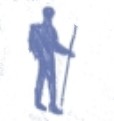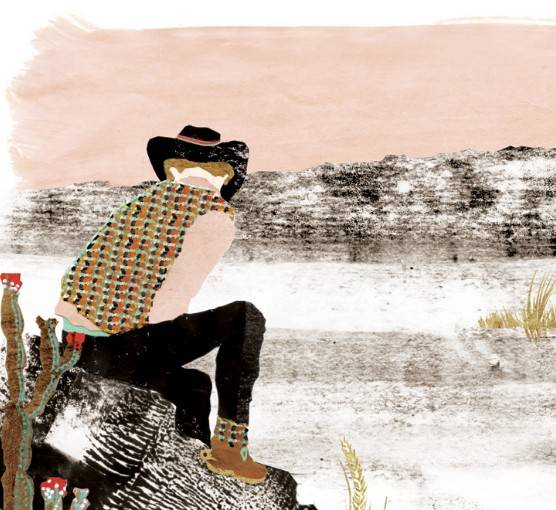Published in Ernest
May 2021
‘Oh give me land, lots of land under starry skies above/ Don’t fence me in/ Let me ride through the wide open country that I love/ Don’t fence me in…’
The Wild West anthem plays through speakers in this flyblown one-horse town. The swing doors of the saloon creak in the hot wind. Between the bank and the county jail, two cowboys squint at one another from under the brims of their sombreros, trigger fingers quivering over the handles of holstered guns. A horse stamps and shakes its tail. Spectators hold their breaths. One man draws. Two shots ring out. One man – the baddie – falls.
Tequila shots slide down the bar. Two cowboys, including the one who died, trade wisecracks with the barmaids, who are dressed as prostitutes. There is a three-way poker game, an argument, a bar brawl complete with men being pistol-whipped, chairs smashed over heads and someone getting flung head-first through the saloon doors. Another volley of pistol-fire and the bodies hit the floor.
The spectators make polite applause and go to buy souvenirs.
Tabernas, in the south-east of Spain, holds the distinction of being Europe’s only desert (defined as an arid region that receives less than 250mm of precipitation per year). Culturally this is not Europe, however, but an exclave of the Old West. Beyond the brick and adobe walls of this replica frontier town, on the other side of a scrubby rise that displays the TEXAS HOLLYWOOD sign – a knock-off of the more famous sign 5,000 miles further west – stretch a hundred square miles of sun-cracked clay, barren hills and steep-sided ramblas or ravines, a landscape that could easily pass for the badlands of Utah or Arizona. That resemblance was first noted by an Italian film director in the early 1960s, who came here searching for a cheap location to make a Western film.
His name was Sergio Leone, and his film Per un pugno di dollari, or A Fistful of Dollars – starring a little-known TV actor by the name of Clint Eastwood – inspired a generation of gritty ‘Spaghetti Westerns’. For a Few Dollars More came out in 1965, The Good, the Bad and the Ugly in 1966, and over the following decades hundreds of other films were shot here, some set in alternative times and places (the Middle East in Lawrence of Arabia and Indiana Jones and the Last Crusade, the fantasy Hyborian wilderness in Conan the Barbarian) but overwhelmingly the rugged landscapes of the American West. Posses of lawmen, Mexican bandits, Native American warriors (not uncommonly played by local Roma) and yee-hawing, gunslinging cowboy heroes filled these ramblas with gunsmoke and blood, indelibly linking these cracked canyonlands a few miles north of the Mediterranean with the macho mythology of the American frontier.
These days the iconic film sets, while still used for shooting on occasion, have mostly been converted into theme parks, like the one in which I witness the gunslinging and bar-brawling. The compacted weirdness of these multiple layers of fantasy – scenes from a vanished nineteenth-century frontier, as reimagined a century later by Italians who had never been to America, now reenacted twice a day in the south-east corner of Spain – is as complex as the striated geology of the ramblas. One day, walking in the desert, I hear the grandiose, soaring theme of Once Upon a Time in the West – composed by Leone’s childhood friend, the great Ennio Morricone – seemingly emanating from a red cliff, as if the rock were singing. Eventually I work out that the music is coming from the nearby theme park of Western Leone, invisible from where I am standing, but, for a few surreal moments, it feels as if the American West, in all its bloodsoaked glory and its epic, tragic violence, has somehow infected the land itself, an electronic haunting.
Perhaps the most striking thing about Tabernas is the way in which this distorted American dream has come to displace the actual history of the region — specifically the centuries-long North African presence here. From the TEXAS HOLLYWOOD sign, a few ruined walls are visible on a rocky hill: the remains of the ancient Moorish castle at which, so the story goes, the Nasrid sultan Muhammad XIII surrendered nearby Almeria to the reconquering Catholics. The year 1492, most famous as the year when Christopher Columbus reached the New World, was also, in a strange quirk of history, the year that the last Moorish kingdom in Spain was defeated, ending almost 800 years of Muslim occupation. Having finally severed its ties with the Islamic east, Spain went on to colonise the west – and now, half a millennium later, the west has colonised it back. Where once the Arabic call to prayer rang over these eroded hills, now they echo with pistol-fire and the whoops of make-believe cowboys.
*
A few months after I visit Tabernas I am on the other side of Europe, watching another reenactment that, despite its different costumes, stems from a similar reimagining of a mythologised past. The landscape, again, is reminiscent of the lost American frontier – not desert this time but the rolling prairies of the Great Plains. On all sides, from horizon to horizon, level grassland stretches away, producing an effect of sameness and endlessness that is disorienting. This is the Hortobágy National Park in the far east of Hungary, Europe’s largest remaining swathe of uncultivated grassland and a geographical exclave of the Eurasian Steppes. From out of this perfectly flat expanse gallop three dark horsemen.
These csikós are the traditional cattlemen of Hortobágy, cowboys of the Wild East, and their appearance is like something from a fairytale. Instead of sombreros they wear stiff black tricorn hats with bustard feathers in the brims; in place of dusty denims and chaps they are swathed in gorgeous indigo robes, with voluminous trousers and embroidered waistcoats. The display begins with the synchronised, ear-splitting cracking of bullwhips, then the horses are commanded to lie prone on the ground while their riders stand on top of them, swinging their whips around their heads in a display of dominance. Finally one man performs a stunt of quite absurd bravado, thundering across the plain with his feet on the backs of two galloping horses, clutching the reins of a further three horses galloping ahead. This crazy formation, which would not be out of place in an action-packed Spaghetti Western, was first dreamed up by an Austrian painter in the 1920s and only later attempted for real – a peculiar example of life imitating art.
All the other tricks on display, however, have their roots in reality. Back in the days of the betyárs – cattle-rustlers and highwaymen who haunted the Great Hungarian Plain into the late nineteenth century – bullwhips were cracked to accustom horses to the sound of gunfire. The trick of lying prone was developed to evade the soldiers giving chase, horse and rider merging invisibly into the level horizon. Around the same time that Jesse James and Billy the Kid were being mythologised for sticking up banks, stealing cattle and other nefarious crimes, notorious betyars like Jóska Sobri and Sándor Rózsa became the subjects of rollicking ballads that painted them as outlaw heroes resisting government oppression. The struggles took place in parallel. As the West was being won, fences erected across the prairies and the last desperados hunted down, in this lawless region of Hungary — for centuries a frontier zone between European Christendom and the barbarian hordes in the east — control was being asserted over a wild horseback culture that traced its origins back to Hungary’s nomadic past.
Those indigo robes and skirt-like trousers were adopted, some historians say, by the Magyar ancestors of modern-day Hungarians who copied them from Turkic nomads on the steppes of Central Asia. The Hungarian language itself is nomadic, a Uralic tongue that is utterly unlike anything spoken by Hungary’s Indo-European-speaking neighbours, cut off from its origins and stranded in the heart of Europe. Today, as Hungary’s right-wing government foments Magyar nationalism and turns its back on the west, the nineteenth-century movement of Turanism – which promoted links between Uralic-speaking cultures from Central Europe to China – is undergoing a resurgence. A week after watching the csikó show, I am in another part of Hungary at a festival that celebrates the shared culture of the steppes, attended by punk bands, folk musicians, horseback-archery enthusiasts, medieval warfare reenactors and delegations from as far away as Turkey, Kyrgyzstan and Mongolia – a strange combination of far-right nationalism and multiculturalism. There are yurts and shrines to Genghis Khan, cavalry charges and mock battles, and an almost cult-like veneration for Attila the Hun, whose armies devastated Europe in the fifth century. The politics might be confused, and confusing, but when I ask a young man why he identifies with the horseback cultures of the steppe, he gives an answer that would not be out of place beneath the TEXAS HOLLYWOOD sign.
‘I want to be like them,’ he says. ‘Free, always moving.’
Cowboys and csikós, bandidos and betyárs – both sets of national icons represent an ideal of freedom. Tabernas might have replaced its own history with the myths of a faraway continent, while the attendees of this festival are acting out a fantasy version of their own glorified past, but the desire is much the same: to gallop off into the sunset. ‘Oh give me land, lots of land under starry skies above/ Don’t fence me in/ Let me ride through the wide open country that I love/ Don’t fence me in…’ The words might just as well be ringing out from the speakers here, amidst the cracking of bullwhips and the drone of goatskin bagpipes.
Illustration by Kathrin Lang


